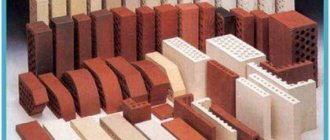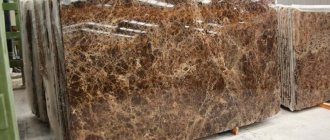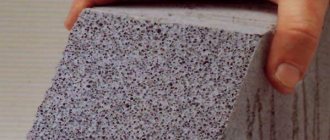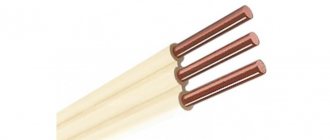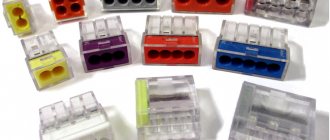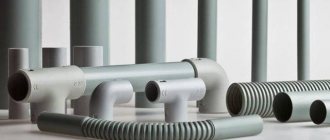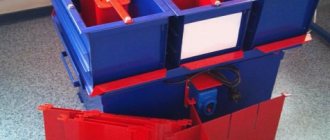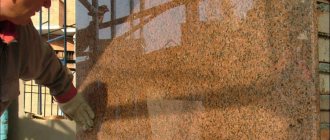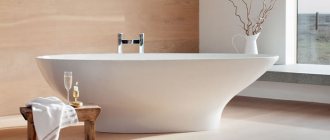Marble, which has excellent decorative properties, has always been valued in construction. But due to the high cost of the material, not everyone can afford to use it to decorate premises. Therefore, an artificial material imitating stone was developed as an alternative. It was called artificial marble.
Description and types of material
Artificial marble is a material that is used primarily in plumbing, in the manufacture of linear and facing materials. It is used to make window sills, bathtubs, countertops, steps, decorative fountains and sculptures. It is used for finishing offices and administrative premises.
The term “artificial marble” refers not only to cast marble, which is an imitation of natural stone. There are other varieties of it that are widely used in construction, industry and interior decoration.
Types of artificial marble:
- injection molding;
- touchstone (or gypsum);
- ground (or crushed);
- flexible (or liquid).
Liteva
The most popular is cast marble - a composite material based on hardened polyester resin and mineral filler. The filler can be marble chips, quartz sand, etc.
Depending on what resins and fillers are chosen, the material can be made as an imitation of natural marble, jasper, granite, malachite, or onyx.
This is what cast artificial marble looks like in the photo
Oselkovy
Touchstone marble is a colored mass of gypsum, sealed with adhesive water, which is applied to the base and brought to a mirror shine by polishing and grinding. It can be tinted to match various materials, such as lapis lazuli, malachite, and different types of marble.
The main material for the production of semolina marble is gypsum. Special substances are added to it that slow down the setting of gypsum. The most commonly used glue is diluted in water.
The advantages of gypsum marble are low weight and high strength. With its help, you can build lightweight structures. The use of this material in residential areas helps improve the microclimate: it absorbs excess moisture or releases it if the room is too dry.
Photo of Oselkov marble
Ground (microcalcite)
Ground or crushed marble is a finely dispersed filler of mineral origin. It is a white or gray powdery substance. It is made by grinding white marble.
This material is characterized by strength, low chemical activity, resistance to ultraviolet rays. It has a bright white color and practically does not absorb moisture. Most often it is used for the production of plastic products, paints and varnishes, abrasive cleaning products, paper, linoleum, etc.
Liquid
This type of marble is one of the newest finishing materials. It consists of marble chips and acrylic polymers.
Liquid marble is very flexible, lightweight and environmentally friendly. It can be easily cut with scissors or a knife and glued to walls instead of wallpaper. Using this material, you can get a perfectly flat, seamless surface. Therefore, it is often used for cladding irregularly shaped structures, such as arches, columns, and spherical objects.
Application of liquid marble
Manufacturing technology
The production of the finished product is not difficult and not expensive; you will need several available materials for making molds and a grinding machine. Do-it-yourself artificial marble is obtained by following the technological process; just follow a few simple steps. The production of artificial marble makes it possible to obtain a finished product of the desired type, give the structure uniqueness, and ensure the proper appearance.
Preparatory work
Before any work you will need the necessary materials. To obtain artificial marble you will need:
- Filler that is selected according to the budget. Ideally, marble chips are used; for a cheaper process, you should pay attention to crushed stone, quartz sand or a cement-sand mixture.
- Depending on the recipe and the desired result, a polyester resin is selected, preferably with an alcohol composition, as saturated as possible.
- Important parameters of high strength are achieved by using a hardener.
- Prepared dyes give the product color.
Read also: Machine for making plywood
Do-it-yourself fillers for making artificial marble
The materials necessary for the production of artificial marble with your own hands can be purchased in specialized stores in construction markets. Only after all the preparatory work is it possible to begin work on the production of a mixture of material.
Preparation of the solution
The solution is prepared in a special container. The prepared ingredients are mixed in accordance with the proportions and recipe; the main requirements for mixing are the absence of lumps and a homogeneous mass at the output. For small volumes, it is possible to use an electric drill with a special stirring attachment, similar to a butterfly. Large volumes are mixed with a construction mixer.
Preparing and filling out the form
Before making a mold, it is necessary to determine whether it is advisable to produce a collapsible mold, because there are designs that are made once. The main materials for making molds are gypsum, polyurethane, plastic and others. The strength of the form depends on the volume and mass of the solution. Flow production involves division into sectors; this method is used when several products are made from a homogeneous composition.
The forms must be pre-polished and material applied to prevent adhesion. The gelcoat is sprayed onto the surface with a special cup device, then allowed to settle until completely cured. After pouring the material, it is necessary to remove air bubbles. This procedure is performed manually by piercing the mass over the entire area; for a faster, automated process you will need a vibrating table.
Hardening depends on the volume of the product and the ambient temperature. Filling is done in small layers to completely fill the form. The appearance of cracks on the surface of artificial marble is avoided by sealing with polyethylene or other available material.
Processing of the finished slab and subsequent care
The finished slab is processed with a grinding machine until shiny. Final polishing is done with felt; for a more pronounced shine, a polish is used, the color of which depends on the product.
Subsequent care requires special care; aggressive detergents can scratch the surface and remove shine. Removal of dirt is done with a soft cloth or a special sponge. To maintain shine, dilute a solution of detergent with water. The shine is maintained by rubbing with a towel after washing.
Production of cast artificial marble
The technology for manufacturing the material is quite simple and will only require special equipment, premises, time and financial resources.
Equipment
To produce cast marble, a small set of equipment is used:
- filling molds (matrices);
- gelcoat sprayer;
- mixer for stirring the composition;
- brushes for greasing molds.
Molds for marble production are made on the basis of polyurethane rubber. High-quality matrices, which are characterized by strength and are not prone to severe deformation, are very expensive. However, their cost pays off in full, since production is highly profitable.
Composition of raw materials
To make the material, acrylic or polyester resin and marble chips are mixed in a ratio of 4:1. For bonding, you can also use cement mortar, building gypsum, lime mortar with the addition of cement. But most often it is resins that are used, since they provide high strength to the material.
The filler function is sometimes performed by decorative materials (colored sand, pebbles, colored quartz). In this case, the finished products are not an analogue of natural stone, but a fundamentally new type of finishing materials.
To achieve the required color, mineral pigments are introduced into the mixture. The material is made in different colors, with inclusions and streaks. For this purpose, a special technique for mixing pigments is used. Pigments not only color the material, but also make it more resistant to external influences. The outer protective layer of gelcoat gives the coating a glossy shine.
Production technology
The technology for manufacturing the material is very simple and not labor-intensive. It involves preparing the matrix, mixing the polyester resin and filler, pouring the resulting mixture into the matrix and curing it.
The artificial marble casting process can be divided into the following stages:
- The molds are polished and a material is applied to prevent adhesion.
- Gelcoat is applied to the molds. For this purpose, a special installation or cup sprayer is used.
- The gelcoat is curing.
- A mixture of polyester resin, filler, pigments and hardener is prepared.
- The mixture is poured into molds.
- The molds are vibrated to remove air from the mixture.
- The material is curing.
- The products are removed from the molds.
- Further processing of the material is carried out (in some cases).
In the video, the production of cast marble and sinks from it:
Nuances of operation
With proper finishing treatment of artificial marble of any origin, products made from it will last for years. One of the ways to increase the durability of the stone is surface painting and coating with water-acrylic varnish.
This is especially true for stone used in exterior decoration, since water-acrylic varnish is not affected by sunlight.
As a result, the marble decorative element will not change its color and will not become covered with unpleasant yellow spots for 10-15 years.
When installing the product, avoid over-tightening fasteners. A marble slab installed skewed or with strong pressure on the corners may not withstand the load and burst. When cladding rooms with high humidity, it is necessary to monitor the condition of the plumbing, prevent leaks and stone from getting under digging.
Falling heavy objects with sharp corners can damage the marble. Do not cut food directly on the countertop; use cutting boards.
The surface should be cleaned using only liquid cleaning agents. Compositions with abrasives destroy the protective coating of artificial stone, causing micro-scratches in which food residues, dust and other contaminants accumulate. Hard brushes and metal meshes should be abandoned, giving preference to soft fabrics.
Read also: Devices for preparing living and dead water
It is also recommended to cover artificial marble with a concrete primer at least once a year after cleaning. In this case, it will last much longer.
Products that imitate natural stones have high strength, resistance to chemicals, environmental friendliness, shock and heat resistance, as well as other advantages. Artificial marble is made from concrete, gypsum and polyester resin and is used not only for cladding houses, but also in the manufacture of…
DIY cast marble
It is quite possible to make artificial cast marble yourself. You just need to purchase all the components of the material, molds for pouring and follow the instructions.
To make cast marble you will need:
- polyurethane casting mold;
- film;
- mixer;
- brush.
In production, the filler is CaMg(CO3)2, and the hardener is Butanox M-50. At home, pebbles and cement can be used instead of these substances.
Materials for making artificial marble:
- sand (river) – 2 parts;
- cement – 1 part;
- water – 0.2 parts;
- pebbles (as filler) – 25% of the total volume;
- pigment – 1% by weight of cement;
- plasticizer – 1% by weight of cement;
- gelcoat
Sequence of production of cast marble:
- A dry and clean mold is coated with gelcoat and allowed to dry.
- Mix sand, pebbles and cement. Add a plasticizer, coloring pigment and water (80%) to the mixture, mix with a mixer to obtain a plastic mass (about 30 seconds). Then add the rest of the water and stir the mixture again until smooth.
- The mixture is poured into a mold, excess is removed from the edges, covered with film and left to harden for 10 hours.
- The material is removed from the mold and left in the open air for some time.
In this simple way, you can obtain a material that can be used in its original form or subjected to further processing to give the desired shape.
The technology for self-production of artificial cast marble is shown in the video below:
Pros and cons, reviews
Although the composition of artificial marble is fundamentally different from its natural counterpart, it has the same technical properties. Moreover, the level of strength and wear resistance of artificially produced material is several times higher than that of natural material.
The main advantages of artificial marble:
- has a high level of mechanical strength and is not afraid of impacts;
- is durable and has a long service life;
- almost does not conduct heat and electricity, has a high level of fire safety. Therefore, it can be used to decorate heating radiators, electric stoves, etc.;
- the material does not heat up, does not delaminate, is not afraid of acids, alkalis, solvents, does not absorb fat, and does not leave stains on it. Due to this practicality, it is often used to decorate kitchens and bathrooms, and finish floors in residential, industrial and public spaces;
- does not emit harmful substances, is environmentally friendly;
- Thanks to the external gelcoat coating, it looks aesthetically pleasing and can be used for decorative purposes.
It combines the hardness of natural stone and ease of processing. Unlike natural marble, artificial material provides a greater degree of comfort and is always warm to the touch.
Among the disadvantages of artificial stone, many note that it cannot be considered a complete analogue of natural material. It feels more like plastic, and the top coating looks like polyurethane.
In addition, the gel coating often cracks over time. As a result, the material becomes discolored and destroyed.
Average cost of artificial marble
The marble manufacturing process involves minimal investment and very high profitability. Initially, costs are incurred for the purchase of equipment, raw materials, rent of premises and production of matrices. In the future, the cost of products is determined mainly by the cost of raw materials.
The production cost is estimated at approximately $5 per 1 sq. m. m., while the market price reaches $30 per 1 sq. m. m. or even higher.
Various products and materials made from artificial marble are considered to be just as beautiful, strong and durable as products made from real natural stone. After all, its production has been improved over the course of 30 years and achieved high results.

